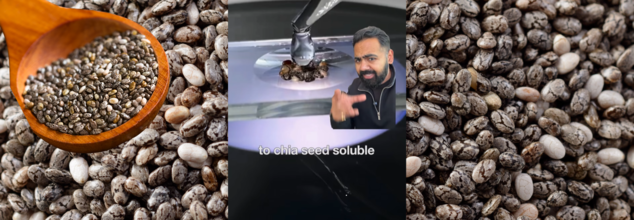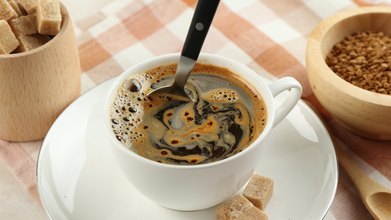- Health Conditions A-Z
- Health & Wellness
- Nutrition
- Fitness
- Health News
- Ayurveda
- Videos
- Medicine A-Z
- Parenting
- Web Stories
Doctor Shares Why Shouldn't You Eat Chia Seeds Dry

Credits: Canva and Instagram
Thanks to medical practitioners on social media who take it on them to spread awareness among people, we know a lot more things now than ever before. We are also way more medically sound. Among many such creators is Dr Karan Rajan, a UK-based surgeon, MRCS, MBBS, BSc, with 1.9m followers on his Instagram account @drkaranrajan. Recently he posted a video where one sees chia seeds under the microscope. While the images are nothing less than amazing, Dr Rajan reminds us why is it important to eat the seeds a certain way.
The video starts with chia seeds being shown under the microscope first without water, then with water. Both the times the images look quite different. The reason is, as Dr Rajan notes, chia seeds contain special nutrients which needs to be unlocked. This is because chia seeds are made of 85% of insoluble fiber and only about 15% of soluble fiber.
"It is the soluble fiber your gut bacteria love to ferment and feast on," he says. He also suggests that in order to optimize access to chia seed soluble fiber, you should hydrate it before eating."
He explains that hydrating chia seeds, by soaking them in water activates the chia's mucilage layer, which is a very potent soluble fiber. "In my opinion it is the most beneficial compound of the chia seeds," he says. The microscopic images too show the release of the layer once water has been poured on it.
What soaking does is, as Dr Rajan explains, it slows down digestion, leading to a stable blood sugar, it also prolongs satiety, which means it makes you feel fuller for a longer period of time. It also acts as a prebiotic, which then feed beneficial gut bacteria.
The soluble water also helps in drawing water into the colon to bulk up the stool and also helping in unlocking your "biological drain pipes".
What Happens If You Eat Chia Seeds Dry?
Dr Rajan says, "If you eat them dry, they will absorb water from your stomach and your intestines, they will still gel. [However], you might not get the full benefits because it depends how hydrated you are. So the prebiotic and laxative effects are less consistent."
"To get the full effect, soak the chia seeds, even if it is just for a few minutes. Make sure you are hydrated yourself well, and for optimal gel formation, use a ratio of chia seeds to water of 1:6. Or you can just blend them into smoothies, yogurts, and oatmeal so they can hydrate while they sit," he explains.
What Are Chia Seeds?
Chia seeds come from the Salvia hispanica plant, a flowering herb native to Mexico and Guatemala. A member of the mint family, this plant produces clusters of small blue-purple blooms where the tiny seeds are found. With their mild, slightly nutty taste, chia seeds blend easily into a variety of recipes without overpowering other flavors.
What truly sets chia seeds apart is their impressive ability to absorb liquid. “Chia seeds can soak up to 10 times their weight in water,” says Maya Brown, chef-instructor at the Auguste Escoffier School of Culinary Arts. This results in a unique gel-like texture that’s often used to thicken dishes or make puddings.
Nutritional Benefits
Chia seeds are among the richest plant-based sources of omega-3 fatty acids—healthy polyunsaturated fats that help lower blood pressure and cholesterol, both key contributors to heart disease. They also offer a boost of plant protein, gut-friendly fiber, and powerful antioxidants that help protect the body’s cells from damage and reduce disease risk.
Is Instant Coffee Slowly Making You Lose Your Eye Sight? Researchers Find Concerning Link With Eye Health

(Credit-Canva)
New research is suggesting a significant connection between drinking instant coffee and a higher chance of getting age-related eye disorder.
Instant coffee may seem like a great way to start your day if you are in a hurry, however, a study has pointed out a major health consequence of drinking it. Published in the Food Science & Nutrition journal, this study showed that instant coffee could increase your risk of age-related macular degeneration (AMD).
Think of AMD as a common eye disease that can hurt your central vision and may even cause permanent blindness, especially for people over the age of 50.
Scientists did a study to look closely at how different types of coffee, ground, decaf, and instant, affect eye health. What they found was surprising. Earlier studies had actually hinted that coffee might be helpful for your eyes, possibly lowering the risk of AMD. However, this new research found the opposite was true for one type:
They discovered that only drinking instant coffee was clearly and strongly linked to an increased risk of getting dry AMD. In short, the study concluded that instant coffee "significantly increases the risk of AMD."
What is Macular Degeneration (AMD)?
The macula is a small spot right in the center of your retina (the light-sensitive layer at the back of your eye). It's crucial because it gives you your central vision, which you use for reading and seeing fine details. There are two main types of AMD:
Dry AMD
This is the most common type. It happens when tiny yellow protein deposits form under your macula, slowly making your central vision blurry.
Wet AMD
This is less common but more serious. It happens when abnormal, fragile blood vessels grow under the macula and leak fluid and blood, causing quick damage.
You are more likely to develop AMD if you smoke, are overweight, have high blood pressure, or if someone in your immediate family has the disease.
How Does Instant Coffee Affect Eye Sight?
Since ground and decaf coffee didn't show this same risk, the researchers believe the difference has something to do with how instant coffee is made.
They suggest that the manufacturing process, which is different from brewing regular coffee, might be creating certain "potentially harmful substances" or involves additives that are not present in other types of coffee. Because of these findings, the researchers give a clear warning: if you are already at high risk for AMD, it's a good idea to avoid drinking instant coffee.
How Is Age-Related Macular Degeneration Treated?
The National Health Services UK explain that there is no cure for AMD right now. However, there are treatments and support available to help slow down vision loss and ensure you can maintain the best possible quality of life.
Your treatment plan will depend on the type of AMD you have, wet or dry. You will work with eye doctors, such as an optometrist, who checks eyes and an ophthalmologist who treats eye diseases.
Treatments for Wet AMD
Wet AMD happens when abnormal, fragile blood vessels start leaking fluid and damaging the eye. The main goal of treatment is to stop these leaks. Doctors use eye injections (called anti-VEGF) of medicine directly into the eye to block the growth of the bad blood vessels, or sometimes use light treatment to destroy them.
Treatments for Dry AMD
Unfortunately, there's currently no medical cure to reverse or stop dry AMD with medicine or surgery. Treatment focuses on supporting your remaining vision. Specialists offer low vision help by teaching you to use tools like bright lights and magnifiers. They also recommend lifestyle changes like specific diets and habits to protect your eye health.
Drinking Energy Drinks Often? Your Heart And Brain May Pay The Price

Credits: Canva
Energy drinks have become a common pick-me-up, marketed as quick fixes for sharper focus, improved alertness, and instant energy. Whether you are working late or driving for hours, grabbing a can may feel like the easiest way to stay awake. Yet once that caffeine rush fades, what lasting effects does it leave on your heart, brain, and sleep?
The FDA has received several reports connecting energy drink intake to deaths and serious side effects such as spikes in blood pressure, seizures, and irregular heart rhythms. Many of these incidents required hospital treatment.
Between 2022 and 2023, America’s Poison Centers recorded a 24.2% rise in cases of children and teenagers under 20 being exposed to energy drinks. Worryingly, around 78% of these were accidental, most youngsters did not realize how much caffeine they were consuming or even that their drink contained it.
How Energy Drinks Can Overstimulate Your Heart
Studies have shown that energy drinks can disrupt normal heart rhythm. People who consume them often experience higher blood pressure and irregular heart activity that can last for several hours, which may increase the chance of dangerous arrhythmias.
Caffeine stimulates the sympathetic nervous system, raising heart rate and blood pressure. But unlike coffee, energy drinks combine caffeine with other stimulants such as guarana, taurine, and L-carnitine, which amplify caffeine’s impact, according to researchers at Jefferson Health.
They also note that one can of an energy drink may contain far more caffeine than a standard 8-ounce cup of coffee. The FDA generally considers up to 400 milligrams of caffeine a day to be safe for healthy adults with no heart problems.
Although experts points out that the caffeine difference between coffee and energy drinks may not appear large, labels can be misleading. A cup of coffee contains about 90 mg of caffeine, while energy drinks can range from 100 to 350 mg, sometimes even more when a single can holds multiple servings. Reading labels carefully helps you understand how much caffeine you are really consuming.
Energy Drinks Contain Excess Calories
Along with caffeine, these drinks are often loaded with sugar and calories. Many specialty coffees, packed with syrups, whipped cream, and heavy dairy, fall into the same category. Regularly consuming such beverages increases the risk of weight gain, obesity, and type 2 diabetes, all of which harm heart health.
Dr. Reginald Ho, a cardiologist, explains that over time, this pattern can lead to high blood pressure, rapid heartbeat, and other cardiovascular diseases.
Energy Drinks Can Lead to Stroke Issues
Energy drinks may also raise the risk of stroke. A stroke is often described as a “heart attack in the brain.” One condition linked to these drinks is reversible cerebral vasoconstriction syndrome (RCVS), which involves sudden spasms in the brain’s blood vessels that can either restrict blood flow or cause bleeding, as noted by the Cleveland Clinic.
Caffeine blocks adenosine, the chemical that helps the brain relax, so even when you feel tired, your mind remains overstimulated. This disruption affects your sleep cycle and can cause poor memory, low concentration, mood swings, anxiety, and even depression.
Can You Mix Energy Drinks With Alcohol?
Health experts have repeatedly warned against mixing alcohol with energy drinks. The FDA has stated that adding caffeine to alcohol makes for an “unsafe additive.”
Caffeine’s stimulant effect masks alcohol’s depressant properties, allowing people to drink more without feeling its sedative impact. This can lead to misjudging one’s level of intoxication and even driving while impaired.
While energy drinks may promise a quick fix for fatigue, their risks to the heart, brain, and sleep are real. Choosing natural ways to stay energized, through rest, hydration, and balanced nutrition, is far better for long-term health.
What Your Odd Food Cravings Could Be Warning You About

Credits: Canva
Have you ever had a weird craving that you were not able to justify? These are not just night-time craving that happens because you spend the time studying. These cravings happen at anytime, however, even after you ate the snack, you did not feel better. If so, then there could be an underlying reason for it, including a reason which could adversely impact your health.
What Does Your Craving Say About Your Health?
Chocolate
A sudden craving for sweet or creamy chocolate could be related to magnesium. As per Nebraska Medicine, chocolate bar, especially dark chocolates contain magnesium, iron and fiber. If you are anemic, or have low iron, you could be craving a chocolate, because your body is actually telling you to consume iron. While chocolate has a small amount of iron, it is easily accessible. Furthermore, craving chocolate could also indicate a magnesium deficiency, which is related to energy production and mood regulation.
Salt
When you are craving something salty, it is not only because you want something savoury, but could be because you are dehydrated.
There are several studies that show people who are on medications waste salts, known as diuretics. This is why people may crave salt. However, only some diuretic medications cause this, the main reason could be dehydration. When you sweat a lot, your body loses both water and sodium, this also leads to you craving something salty. The best thing to do would be to drink water or electrolyte solutions, approved with the World Health Organization (WHO), and your doctor.
Clay, Ice, Chalk, Paper
All of them sound weird, however a condition called pica, could actually make you crave all this. This happens when your body craves non-food items. Mayo Clinic suggests that craving ice, called pagophagia, is often related to low iron, this could be with or without anemia. Several studies, including a 2010 study by Y Khan, also revealed that pica is an unusual condition where patients develop cravings for non-nutritive substance, usually linked with iron deficiency.
Craving Carbs
Craving food high in carbohydrates like pasta, or bread could be because you do not sleep well. These food items are a quick source of energy, and when you do not get enough sleep, your body craves for energy, usually the fastest source.
Red Meat
This indicates that you may be lacking iron and zinc. Studies have shown that red meat, while recommended to not be consumed often, could make a healthy diet. Some studies have shown benefits with a small amount of red meat.
Other Factors Why Your Body Craves
While one reason your body craves certain food item is related to lack of nutrition, there could be other factors too, including:
- Hormonal changes, whether from stress, sleep deprivation, or pregnancy
- Low blood sugar could also be a reason why your body may crave for a quick energy source
- Dehydration: not drinking enough fluids could also intensify feelings of hunger and lead to cravings
- Boredom: When you do not have anything to do, this could further trigger a craving for unhealthy snacks just to have something to do
© 2024 Bennett, Coleman & Company Limited

